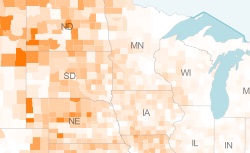Maps: Agriculture in the U.S. and Around the World
Where do most farmers live? Which countries feed the world?

Read more from Slate’s special issue on the future of food.
Which counties, states, and countries have the biggest stake in food and its future? Look to these three maps to find out.
Percentage of farmers in each county
The Midwest is the country’s farming powerhouse. In the small farming communities of the Midwest, farmers often account for one-third of the population, especially in North Dakota, South Dakota, and Kansas. On the coasts, just one or two out of every 100 people work as farmers, even in rural areas. The county with the greatest percentage of farmers is McMullen, Texas. The town’s population is 707, with 374 farmers—that’s more than half of its entire population. If you exclude children and the elderly, the proportion of farmers is even greater. No matter how urban your landscape, though, there’s probably a farmer in the range of a short drive. San Francisco, which has the fewest farmers of all, still boasts six.
Crop value per person in each state
A state’s value of crops per person reflects the fraction of farmers in its population and illustrates the extent to which some states depend on the agricultural industry. Although the most populous states, such as California, generate the most total crop value, sparsely populated farming states generate the most per resident.
Food imports and exports around the globe
Like nearly all countries in South America and North America, the United States is a net importer of food, exporting $1.28 in food for every dollar it imports. The countries most reliant on food imports are tiny and urban, such as Dijbouti, Tuvalu, and Brunei, which have virtually no space for agriculture. Other countries that depend heavily on the food of others include Middle Eastern countries, some Asian countries, and developing African countries. The biggest net food exporter is Argentina, which exports about $23 in food for every $1 it imports.
Also in the special issue on food: five “food frontiers," including technologies to make diet food tastier and fight salmonella; small-scale farmers decide whether to embrace automated agricultural equipment; the United States and Europe switch perspectives on genetically modified foods; the cookbook will soon be a thing of the past; and the case for bringing back home ec. This project arises from Future Tense, a joint partnership of Slate, the New America Foundation, and Arizona State University.